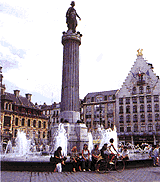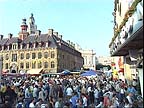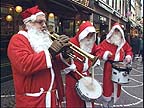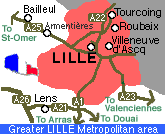Places to
visit |
Where
to eat |
Local
area map|
Lille
& the greater Lille metropolitan area Europeam City of
Culture 2004,
starting 6 Decemeber 2003............Find
out more>>> http://www.lille2004.com
![]() | Lille
City Pass
|
MULTIMAP
| Lille
City Pass
|
MULTIMAP

|
|
Metropolitan
Lille Transformation Re-discovered
heritage Lively
atmosphere |
|
|
|



1. Euralille - huge modern shopping complex in the space between Lille's two main railway stations
2. Old buildings, pedestrian streets and shops in Old Lille
3. Lille's modern Metro has automatic driverless trains - the "VAL"
Old Lille is rich in interesting old streets and museums. The central area also has attractive and popular "green areas", fine riverside walks. and a riverside tramway.
Visitors find the many street markets particularly exciting - especially about the famous 'braderies' when miles of streets are lined with second-hand stalls, flea markets - something for everybody! (Often called “foires brocantes” or “marchés aux puces”.)
 Lille's new giants "Phineart" and "Lydéric" were "born" in 1999 |
Stormy
history In the 14th century, Flanders came under the Dukes of Bergundy when Marguerite of Flanders married Philip the Bold of Bergundy. Other marriages brought the different parts of Bergundy including Flanders under Spanish control. During this period, the tradition started of "giants" as a centrepiece of festive carnivals and processions. See the background page on "carnivals and giants" for more information about this colourful tradition. |
In 1667 Louis XIV of France besieged and captured Lille, erecting a huge triumphal arch similar to the Arc de Triomphe in Paris to mark his victory. Shortly afterwards he sent his military engineer Vauban to build strong fortifications, including the Citadelle which you can tour today.
Textile
industry
In the 18th century many cotton
and linen mills were opened in the Lille area. Tourcoing just
north of Lille specialised in wool. Oil was milled from seed crops
such as linseed grown in the north. By the early 19th century, it was
like the Manchester of northern France - with equally appalling and
unhealthy slums. A large coalfield
running from south of Lille into Belgium was opened up with many
mines and slag-heaps scarring the landscape. Coal and other bulk
goods were transported by barges using the area's network of
canals - and later railways.
Lille in the 1st World
War
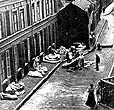
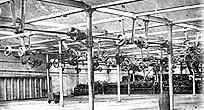
Houses shelled in the brief siege before
occupation 1914. Mattresses and household linen were requisitioned by
the occupying troops. Textile mills were stripped of machinery that
was transported to Germany.
In 1914 the French at first withdrew the army from Lille and
declared it an "open city", because they felt its flat site made it
too difficult to defend against the invading Germans. The occupying
forces systematically looted the North and subjected those
inhabitants who did not flee to a harsh regime for the duration of
the war. [see First World
War]
|
Web
links and more information |
Click on places for more information, and |
||||
|
|
Where to eat
in Lille
- we recommend: |
||||
|
Places
to visit in central
Lille |
|||||
|
Places
to visit in greater
Lille area
|
|||||
 QUICK TOUR round Greater Lille, starting with the Palais des Beaux-Arts... |
|||||
|
Background Information |
|||||
|
|
|
|
|
|
|
|
|
